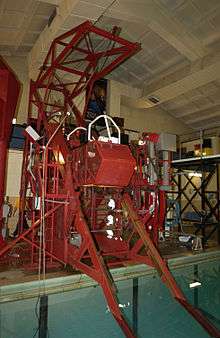Dilbert Dunker
The Dilbert Dunker is a device for training pilots on how to correctly escape a submerged plane.

It was invented by Ensign Wilfred Kaneb, an aviation engineer at NAS Pensacola, in 1943–1944.[1][2]
Originally named the "Underwater Cockpit Escape Device," the device was known since its earliest days as the "Dilbert Dunker" in reference to Dilbert Groundloop, a World War II-era cartoon character in Navy aviation training videos and posters who is incapable of doing things right.[1]
The original Dilbert Dunker combined the forward fuselage of an SNJ Texan—including "all equipment in the cockpit that would hinder a pilot’s exit" (instrument panel, stick, and pedals)—with a 45 degree rail that sends the cockpit from a high stand at the deep end of the training pool, and at the end of the run under water it flips inverted to simulate a water ditching. The cockpit would hit the water at 25 miles per hour (40 km/h) before inverting. The preflight student must detach the communication wire from the helmet, release the seat and shoulder harness, dive still deeper and swim away from the "aircraft" at a 45 degree angle to the surface for the purpose of assuming that the water around an actual situation has burning fuel on the water's surface.[1]
The Dunker was still in use as of 1997,[2] and a helicopter-specific version remains in service as of 2013 even though the original version has fallen out of service.[1]
In popular culture
The device was featured in the 1982 film, An Officer and a Gentleman, starring Richard Gere and Debra Winger.[1][2]
The device is used as a test for astronauts in the novel The Calculating Stars by Mary Robinette Kowal.
References
- "The Birth of the 'Dilbert Dunker'". National Naval Aviation Museum. 6 September 2013. Retrieved 23 February 2019.
- Kaneb, Wilfred (August 1997). "Dilbert Memories". Popular Science. Bonnier Corporation. Retrieved 23 February 2019.